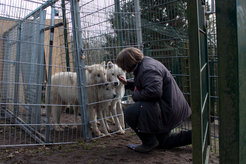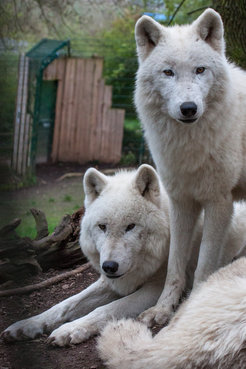Cooperation and Domestication
Scientists at the MPI-SHH and MPI-EVAN compare the cooperation behavior of wolves and dogs

To address these questions, Juliane Bräuer and colleagues at the Max Planck Institute for the Science of Human History in Jena and the Max Planck Institute for Evolutionary Anthropology in Leipzig have tested Arctic wolves at the Wildlife Park Petersberg near Halle (Saale) in Germany. For this purpose, pairs of wolves had to solve a problem together in order to get a reward – similar to how wolves must cooperate to hunt prey in the wild.
The wolves in the wildlife park were willing to be tested, which is very rare for these wild animals. Often they do not lose their timidity in zoos and wildlife parks. All of the pairs that were tested were able to solve a problem by cooperating. In April, the studies at the Wildlife Park Petersberg were completed, which would not have been possible without the great support of the employees of the park.

The scientists are currently testing a comparable group of dogs with the same methods.
Once the tests on the dog group are completed, the analysis of the data will begin. In addition to the comparison of wolves and dogs, the biologists are also interested in how the cooperation behavior changes over the course of trials. Furthermore, they are interested in investigating how dogs and wolves share their food, if some animals are especially good at cooperating, and if the animals understand that they need a partner in order to solve a particular problem.
It will likely take until the end of the year until we know more precisely how dogs and wolves cooperate with one another.

